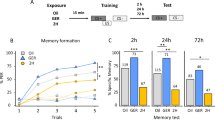Summary
The proboscis extension reflex was used for conditioning worker and drone bees to odours. Six odours, including queen substance and the scent to the Nassanoff gland were used as conditioning stimuli. The animals could clearly distinguish the odours from one another.
Zusammenfassung
Mit Hilfe des Rüsselreflexes gelang es, nicht nur Arbeiterinnen, sondern auch Drohnen auf Duftstoffe zu dressieren. Jeder der sechs verwendeten Duftstoffe, darunter Königinsubstanz und Sterzelduft, konnte als Dressurduft von den übrigen Düften sicher unterschieden werden.
Similar content being viewed by others
Literatur
Boch, R., Shearer, D. A.: Indentification of nerolic and geranic acids in the Nassanoff pheromone of the honey bee. Nature (Lond.) 202, 320–321 (1964).
Butler, C. G., Calam, D. H.: Pheromones of the honeybee — the secretion of the Nassanoff gland of the worker. J. Insect Physiol. 15, 237–244 (1968).
Frings, H.: The loci of olfactory end-organs in the honey-bee, Apia mellifera. J. exp. Zool. 97, 123–134 (1944).
Frisch, K. v.: Über den Geruchssinn der Biene. Zool. Jb., Abt. allg. Zool. u. Pysiol. 37, 1–238 (1919).
Kaißling, K.-E., Renner, M.: Antennale Rezeptoren für Queen Substance und Sterzelduft bei der Honigbiene. Z. vergl. Physiol. 59, 357–361 (1968).
Kuwabara, M.: Bildung des bedingten Reflexes von Pavlovs Typus bei der Honigbiene, Apis mellifica. J. Fac. Sci. Hokkaido Univ. Ser. VI, Zool. 13, 458–464 (1957).
Lacher, V.: Elektrophysiologische Untersuchungen an einzelnen Rezeptoren für Geruch, Kohlendioxyd, Luftfeuchtigkeit und Temperatur auf den Antennen der Arbeitsbiene und der Drohne (Apis mellifica L.). Z. vergl. Physiol. 48, 587–623 (1964).
Renner, M.: Das Duftorgan der Honigbiene und die physiologische Bedeutung ihres Lockstoffes. Z. vergl. Physiol. 43, 411–468 (1960).
Schwinck, I.: Experimentelle Untersuchungen über Geruchssinn und Strömungswahrnehmung in der Orientierung bei Nachtschmetterlingen. Z. vergl. Physiol. 37, 19–56 (1954).
Takeda, K.: Classical conditioned response in the honey-bee. J. Insect Physiol. 6, 168–179 (1961).
Author information
Authors and Affiliations
Rights and permissions
About this article
Cite this article
Vareschi, E., Kaissling, K.E. Dressur von Bienenarbeiterinnen und Drohnen auf Pheromone und andere Duftstoffe. Z. Vergl. Physiol. 66, 22–26 (1970). https://doi.org/10.1007/BF00297795
Received:
Issue Date:
DOI: https://doi.org/10.1007/BF00297795




